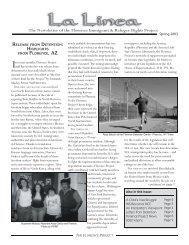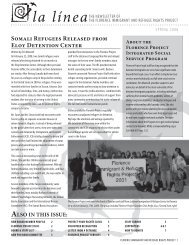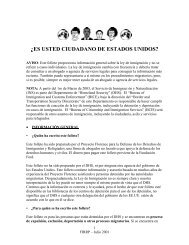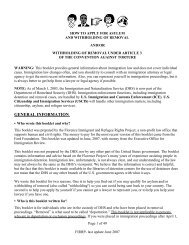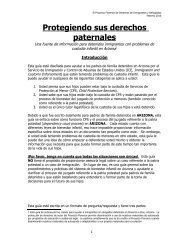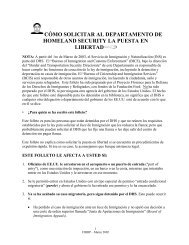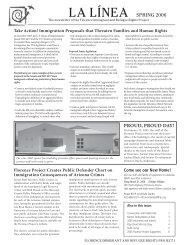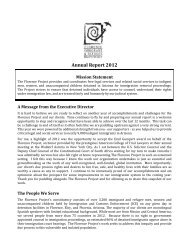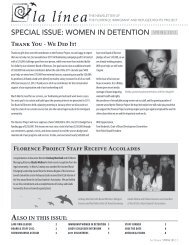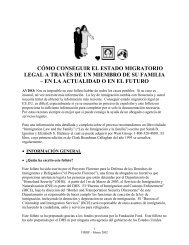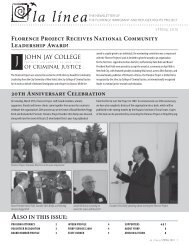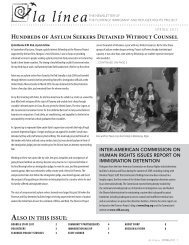quick reference chart and annotations for determining immigration ...
quick reference chart and annotations for determining immigration ...
quick reference chart and annotations for determining immigration ...
Create successful ePaper yourself
Turn your PDF publications into a flip-book with our unique Google optimized e-Paper software.
Immigrant Legal Resource Center, Florence Immigrant <strong>and</strong> Refugee Rights Project,<br />
Maricopa County Public Defender August 2012<br />
under section 16(b)). Since the statute can only be violated using recklessness, it is categorically not an<br />
aggravated felony. See further discussion at ARS § 13-1203, assault.<br />
Other Grounds: Domestic Violence. This is not a crime of domestic violence because it is not a<br />
crime of violence.<br />
Other Grounds: Crime of Child Abuse, Neglect or Ab<strong>and</strong>onment: If the record demonstrates<br />
that the person endangered was a minor, charges of removal may be brought on the basis of child abuse,<br />
neglect, or ab<strong>and</strong>onment. See Matter of Soram, 25 I&N Dec. 378 (BIA 2010) (unreasonably placing a<br />
child in a situation that poses a threat of injury to the child’s life or health is categorically a crime of child<br />
abuse even though no proof of actual harm or injury to the child is required). However, Matter of Soram<br />
may be in conflict with the Ninth Circuit’s decision in Pacheco-Fregozo v. Holder, 576 F.3d 1030 (9th<br />
Cir. 2009), which held that a statute that includes only the possibility of harm, with no actual physical or<br />
emotional injury, does not categorically fall within the definition of a “crime of child abuse.” See<br />
Jimenez-Juarez v. Holder, 635 F.3d 1169, n.2 (9th Cir. 2011) (upholding Pacheco-Fregozo post-Soram).<br />
Defense counsel should plead to language that avoids any <strong>reference</strong> to actual harm or injury to the victim<br />
in order to preserve this argument <strong>for</strong> <strong>immigration</strong> counsel.<br />
Defense counsel should attempt to cleanse the record of any mention that victim was a minor. If<br />
the age of the victim is in the record of conviction, <strong>immigration</strong> counsel should argue that the BIA’s<br />
decision permitting this in Matter of Velazquez-Herrera, 24 I&N Dec. 503 (BIA 2008), was an incorrect<br />
interpretation of Ninth Circuit law, <strong>and</strong> implicitly overruled in United States v. Aguila-Montes de Oca,<br />
655 F.3d 915, 937 (9th Cir. 2011) (en banc). In an age-neutral statute, the fact that the victim was a minor<br />
is a “non-element fact” because it does not set out an element that is set out in the criminal statute.<br />
Neither is the minor age of the victim necesassary to prove any element of the offense that is set out in the<br />
criminal statute. There<strong>for</strong>e an <strong>immigration</strong> judge may not consider this fact in characterizing the offense<br />
of conviction.. United States v. Aguila-Montes de Oca, 655 F.3d 915, 937 (9th Cir. 2011) (en banc).<br />
Other Grounds: Firearms: If the record demonstrates that the offense was committed with a<br />
firearm, a charge of removal may be brought on the basis of a firearms conviction. 8 USC §<br />
1227(a)(2)(C). Unlike the age of the victim, see Other Grounds: Crime of Child Abuse, Neglect or<br />
Ab<strong>and</strong>onment, <strong>immigration</strong> counsel would probably not be able to argue that the firearm was not<br />
“actually required” in order to convict the defendant of the offense. See United States v. Aguila-Montes<br />
de Oca, 655 F.3d 915, 936-37 (9th Cir. 2011) (en banc). Defense counsel should be careful to remove<br />
any <strong>reference</strong> to a firearm from the record of conviction. If it is not possible to remove any <strong>reference</strong>,<br />
defense counsel should refer generally to a “gun” or “bb gun,” which will permit <strong>immigration</strong> counsel to<br />
argue that the offense is not properly identified as a “firearm” under the federal <strong>immigration</strong> definition at<br />
18 USC § 921(a)(3)..<br />
10. Threatening or intimidating, ARS § 13-1202<br />
A person commits threatening or intimidating if the person threatens or intimidates by word or<br />
conduct: 1. To cause physical injury to another person or serious damage to the property of another; or<br />
2. To cause, or in reckless disregard to causing, serious public inconvenience including, but not limited to,<br />
evacuation of a building, place of assembly or transportation facility; or<br />
3. To cause physical injury to another person or damage to the property of another in order to promote,<br />
further or assist in the interests of or to cause, induce or solicit another person to participate in a criminal<br />
street gang, a criminal syndicate or a racketeering enterprise.<br />
Arizona Criminal Chart with Explanatory Endnote – August 2012<br />
21



